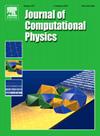Entropy-stable model reduction of one-dimensional hyperbolic systems using rational quadratic manifolds
IF 3.8
2区 物理与天体物理
Q2 COMPUTER SCIENCE, INTERDISCIPLINARY APPLICATIONS
引用次数: 0
Abstract
In this work we propose a novel method to ensure important entropy inequalities are satisfied semi-discretely when constructing reduced order models (ROMs) on nonlinear reduced manifolds. We are in particular interested in ROMs of systems of nonlinear hyperbolic conservation laws. The so-called entropy stability property endows the semi-discrete ROMs with physically admissible behaviour. The method generalizes earlier results on entropy-stable ROMs constructed on linear spaces. The ROM works by evaluating the projected system on a well-chosen approximation of the state that ensures entropy stability. To ensure accuracy of the ROM after this approximation we locally enrich the tangent space of the reduced manifold with important quantities. Using numerical experiments on some well-known equations (the inviscid Burgers equation, shallow water equations and compressible Euler equations) we show the improved structure-preserving properties of our ROM compared to standard approaches and that our approximations have minimal impact on the accuracy of the ROM. We additionally generalize the recently proposed polynomial reduced manifolds to rational polynomial manifolds and show that this leads to an increase in accuracy for our experiments.
求助全文
约1分钟内获得全文
求助全文
来源期刊

Journal of Computational Physics
物理-计算机:跨学科应用
CiteScore
7.60
自引率
14.60%
发文量
763
审稿时长
5.8 months
期刊介绍:
Journal of Computational Physics thoroughly treats the computational aspects of physical problems, presenting techniques for the numerical solution of mathematical equations arising in all areas of physics. The journal seeks to emphasize methods that cross disciplinary boundaries.
The Journal of Computational Physics also publishes short notes of 4 pages or less (including figures, tables, and references but excluding title pages). Letters to the Editor commenting on articles already published in this Journal will also be considered. Neither notes nor letters should have an abstract.
 求助内容:
求助内容: 应助结果提醒方式:
应助结果提醒方式:


